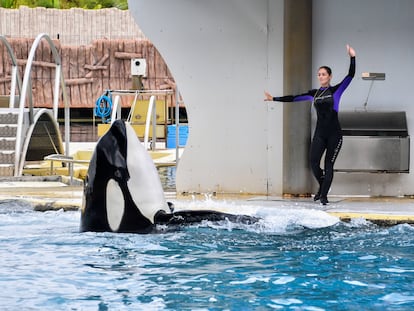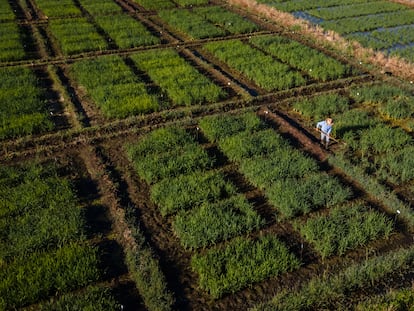Too many capybaras: Rodents face vasectomies in luxury Argentine community
Residents of the Nordelta gated community, built on a wetland, complain that the population of the species has tripled in just over three years
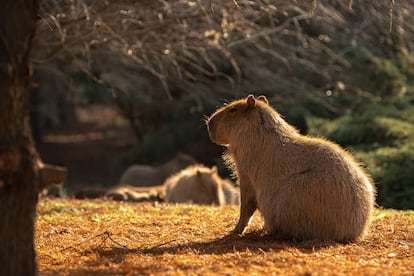

Nordelta is one of Argentina’s best-known gated communities. Built two decades ago on a wetland neighboring the Luján River, north of Buenos Aires, it now has 45,000 wealthy inhabitants, living in landscaped homes with views of lakes and streams. The habitat has changed in the past 20 years, but it is still a tempting one for one of its former occupants, the capybaras, whose numbers have tripled to more than 1,000 in just over three years. Most neighbors have gone from viewing these giant rodents with sympathy to reporting attacks on pets and destruction of plants. Many are now demanding something be done.
The Buenos Aires government has just approved wildlife population control plans that include selective sterilization and contraceptives with which they hope to reduce the rate of reproduction and solve the growing coexistence problem. Outside the walls of the gated community, the issue has become a source of amusement.
As the largest rodent in the world, the adult capybara can weigh up to 60 kilograms (132 pounds) and measure 1.30 meters long. They are vegetarian, amphibious and live in colonies consisting of a dominant male, several females and their young.
“From the window I see eight capybaras, four adults and four young. Some are in the water. The family has about 15 members,” says Marcelo Cantón, spokesman for the Nordelta Neighborhood Association. A resident for 20 years, Cantón says that although there have always been capybaras, they were scarce until 2020. After that, their numbers surged.
“This is an almost perfect environment for them. They have plenty of space for shelter and food and nobody hunts them,” he says, adding that Nordelta has around 500 hectares of lakes and green spaces. Without their natural predators, such as the puma, and poachers who shoot them for food, the capybaras have accelerated their reproductive cycle.
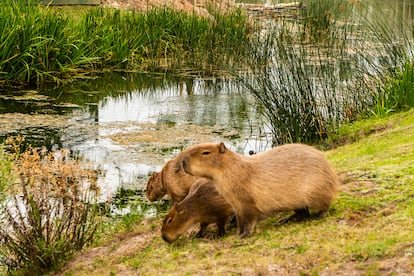
“Capybaras are rodents, and like all species within this group, they reproduce quickly. Each female can have two births a year, with up to eight offspring in each litter,” says a spokesman from the Ministry of Agrarian Development in Buenos Aires province. “Nordelta used to be a wetland and still has wetland characteristics, but now it is a semi-urbanized area and requires wildlife management,” he adds.
The approved plan consists of injecting two doses of contraceptives into 250 animals, which will stem reproduction for between nine months and a year. “It will be carried out by a group of vets specializing in wildlife because they have to be captured not once, but twice,” says Cantón. The results will be supervised by biologists from the National Council for Scientific and Technical Research (Conicet). “They were going to start this week, but it was delayed because of the rains. The idea is to start as soon as possible,” he says.
Cantón adds that the biggest coexistence problem occurs with dogs because both dogs and capybaras are territorial animals: “People reinforce the fences of their houses to avoid confrontation with their dogs and also altercations involving children because although the capybara is not aggressive, a female with young will become aggressive if approached.”
Cantón says there is one group of inhabitants that considers these rodents a plague and wants them gone by any means necessary. “Then there are others who want them left alone,” he says, adding that most are in favor of the contraceptive controls.
Among those who are asking for alternative solutions is Silvia Soto and a group of neighbors calling themselves Carpinchos Nordelta – Somos Su Voz (Nordelta Carpinchos – We Are Your Voice). Soto complains that there was no consultation on the initiative, with neighbors informed of it via email. She also says that the real estate developer has ignored proposals such as creating biological corridors or protected areas; she believes that the current crisis is related to the destruction of an area which is now the civic center, which was the capybaras’ last refuge.
“They say there is no space to make biological corridors, but there is space to continue building,” she says. Soto adds that the number of rodents has decreased in the past couple of months and suspects this is due to illegal hunting.

Vasectomy for dominant males
Conicet confirms that they will monitor the population control plan but insists that they did not recommend or suggest it. “In Brazil there is a [contraceptive] vaccine that is a single dose, can be applied remotely using darts and has been shown to work with capybaras, but it is not available in Argentina. The one available here was not tested for capybaras and requires the capture of the animal for one dose and recapture for the second,” says María José Corriale, a Conicet researcher specializing in the relationship between habitat and wildlife.
Corriale’s team is working on another similar project: they have performed a vasectomy on five dominant males from the colonies present in Nordelta to see if it reduces fertility. “This is a more observational study. We proposed it two years ago, but it has only been approved now,” she says. She has been following the growth of the capybara population in Nordelta for years and agrees that the conditions are optimal for the reproduction of the species, although she adds that the fences put up by the neighbors together with their population growth means more competition between the rodents for territory and food.
Some environmentalists are calling for no action to be taken against capybaras and, instead, for a law to be passed to protect the wetlands and prevent any construction on them, questioning the environmental sustainability plans that allowed neighborhoods like Nordelta to crop up. Others point out that there are people who want to live in nature, while wanting to get rid of its natural inhabitants, whether they be capybaras in Nordelta or foxes in nearby neighborhoods.
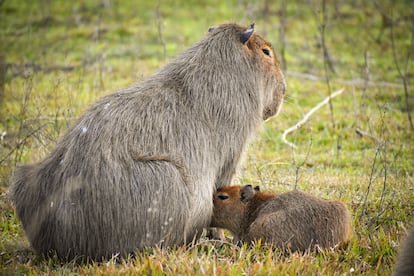
Sign up for our weekly newsletter to get more English-language news coverage from EL PAÍS USA Edition
Tu suscripción se está usando en otro dispositivo
¿Quieres añadir otro usuario a tu suscripción?
Si continúas leyendo en este dispositivo, no se podrá leer en el otro.
FlechaTu suscripción se está usando en otro dispositivo y solo puedes acceder a EL PAÍS desde un dispositivo a la vez.
Si quieres compartir tu cuenta, cambia tu suscripción a la modalidad Premium, así podrás añadir otro usuario. Cada uno accederá con su propia cuenta de email, lo que os permitirá personalizar vuestra experiencia en EL PAÍS.
¿Tienes una suscripción de empresa? Accede aquí para contratar más cuentas.
En el caso de no saber quién está usando tu cuenta, te recomendamos cambiar tu contraseña aquí.
Si decides continuar compartiendo tu cuenta, este mensaje se mostrará en tu dispositivo y en el de la otra persona que está usando tu cuenta de forma indefinida, afectando a tu experiencia de lectura. Puedes consultar aquí los términos y condiciones de la suscripción digital.
More information
Últimas noticias
All the effects of gentrification in one corner of Mexico’s Colonia Roma
Palestinian reporter Youmna El Sayed: ‘My family told me I had to choose between being a journalist or a mother’
Russell Tovey: ‘I was advised many times not to come out, I don’t think there was many people who’d done that — and I feel really proud that I’m one of those that did’
Merz tries to replace Macron at the helm of Europe
Most viewed
- The low-cost creative revolution: How technology is making art accessible to everyone
- Families demand repatriation of bodies of Colombians who died in Ukraine: ‘This war is a slaughterhouse for foreigners’
- Christian Louboutin: ‘Young people don’t want to be like their parents. And if their parents wear sneakers, they’re going to look for something else’
- US sanctions against jailed cartel leader ‘El Marro’ highlight Mexico’s lack of control over its prisons
- Liset Menéndez de la Prida, neuroscientist: ‘It’s not normal to constantly seek pleasure; it’s important to be bored, to be calm’
